Reguired proviters is 310.000. 5. Wosd a makee based trarster price be soresible to tooth orvisional managers? Required 23-36 Transfer pricing, full cost and market-based transfer prices. Compost Systems, Inc. (CSI) operates a composting service business and produces organic fertilizer that it sells to farmers in the Midwest. CSI operates with two divisions, collection and composting. The collection division contracts with universities, hospitals, and other large institutions to provide compostable waste collection bins in their dining service areas, and hauls the waste away daily. The waste providers pay the collection division a monthly fee for this service, and the collection division in turn charges the composting division for the compostable materials at a full-cost transfer price of $200 per ton. Monthly, CSI collects and transfers 1,000 tons of waste. The composting division processes the waste, places it in bins, adds microbes to break down the organic material, and ultimately delivers the fertilizer it produces to farmers for use in their fields. After the removal of water, 1,000 tons of waste produces 500 tons of fertilizer. Demand for the fertilizer has risen steeply as consumer demand for organic produce has increased in recent years. The composting division has demand for an additional 200 tons of fertilizer per month. To provide the 400 tons of compostable waste necessary to meet the increased demand, the collection division will have to invest in additional marketing and equipment that will increase monthly fixed costs by $28,000. Estimated additional monthly revenue to the collection division from waste providers is $10,000. 1. Compute the new full-cost transfer price if it is applied to all waste transferred to the composting division. 2. Compute the new full-cost transfer price if it is applied to just the additional 400 tons. 3. What difficulties do you see in using a full-cost transfer-pricing system in the future? 4. The composting division has identified a source of additional compostable waste at a price of $205 per ton. What would be the impact on the company as a whole if the 400 tons of material is purchased from the outside supplier? As a decentralized unit, what decision would the composting division make regarding the additional material? 5. Would a market-based transfer price be agreeable to both divisional managers









